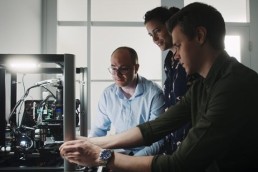How connected sensors can reduce garbage collection stops - by 80%
155 waste bins in parks and along walkways in the Kista area have been equipped with sensors that automatically signal when they need to be emptied.
The project – made in collaboration between the city of Stockholm, two startups and Kista Science City – gives a glimpse of how technology can make our cities more efficient, clean and sustainable.
In every major city, thousands of waste bins are scattered throughout parks, walking paths and public areas where people hang out or pass by.
These bins are emptied on pre-scheduled days, leading to overfilled or underutilized bins. Overfilled bins and litter in inappropriate areas do not only create a negative impression of the city, but also impacts the perceived safety of the surroundings.
But technology offers a pathway to change this.
How connected sensors make a difference
Traditionally, predicting the level of fullness for each waste bin across the city on a particular day has been a challenging task. The rate at which a bin fills up is related to factors like how many people have been passing by (which can vary based on weather, season, local events and other factors), location, proximity to other bins and more.
What if each waste bin could provide real-time updates on its current fill?
Thanks to a sensor, this is now possible.
– Our sensor sends out a pulse of light to a cone-shaped space inside the bin, measuring the speed at which the light reflects from 100 points within that space. The pulse is sent hourly – or every five minutes upon request, providing immediate information on the bin’s fill level. This data is then transmitted in real-time to an online server using low-energy network, explains Anders Helgesson, founder of Norrsidans Innovation AB.
Norrsidans is one of two companies involved in the project to develop solutions for the city. The other one, Bintel, uses similar technology:
– Once the data is transmitted to the cloud, it’s analysed and presented to provide a basis for planning routes, and for long-term improvements, says Daniel Lundell, Bintel.
Game-changing results
The connected bins were normally emptied 7138 times per week. When emptied only when full, garbage collectors only needed to stop by 1072 times. Overall, waste disposal stops could be reduced by up to 80% per week while ensuring full bins are emptied.
This is a game-changer for waste management in cities.
However, so far, it’s just a test. Until 2024 Rinkeby-Kista is locked to an agreement with a contractor to keep emptying litter bins as scheduled. But once that contract ends, municipality will take back the operations – with a clear intent to build a sustainable and effective organization.
A similar project in Södertälje led to the revelation that one out of three stops were necessary when collecting garbage.
However, optimizing garbage collection routes is just the beginning of the benefits that connected sensors can provide.
Bringing value out of of data
Thanks to sensor-collected data, cities can now make decisions based on validated facts and no longer need to operate blindly.
– The potential is huge. In our dialogue with the city as a whole, we note that data-driven knowledge will become even more important in the years ahead, says Annika Ström, Head of unit for City Development in Rinkeby-Kista district.
As an example, she mentions the upcoming new regulations that make cities responsible for collecting packages for recycling.
– We will need to measure which fractions will fill up fastest, so that those bins can be dimensioned accordingly, at the right locations, and be emptied in an optimised way.
However, more actions are needed to keep the city clean. In Rinkeby-Kista alone, there are on average about four tons of scrap dumped in parks, forests and public lawns every month; everything from car tires to laughing gas cylinders.
More data was added
To address this problem, garbage collectors in the project were asked to register where and when they noticed litter in all the wrong places, allowing the city to gather more data and reveal the extent of the problem.
One interesting finding from this data was that there’s no correlation between full waste bins and lots of littering in the surrounding areas, indicating that adjusting the size or adding more bins is just part of the solution.
The city needs to think of ways to nudge people to do the right thing, which is currently being discussed.
Collaboration for innovation
Data-driven knowledge is needed not only in formulating challenges but also in implementing solutions. Collaboration across borders is often needed to come to that point. Rinkeby-Kista and partners opened up to challenge their old ways.
– The connected litter bins project helped us to think outside the box, says Annika.
Lucas Uhlén, project manager at Kista Science City, emphasizes that each stakeholder learns from each other and gets a much deeper understanding of how data can be collected and used. The real-world experience from such projects brings what’s needed to advance, improve, and eventually scale.
Related Articles
June 30, 2025
Opening doors for Swedish tech: Lessons from Access UK
The boundaries of conflict are shifting. Today, national security isn’t just…
June 9, 2025
Kista companies invest early in future tech talent
The boundaries of conflict are shifting. Today, national security isn’t just…
June 3, 2025
From code to clinic: New lab tech from Qamcom and Mabtech
A new national initiative designed to boost Sweden’s semiconductor sector…



